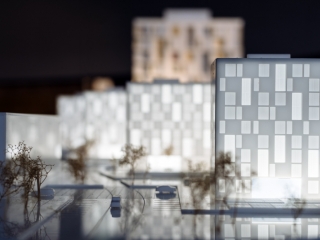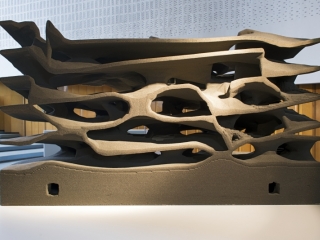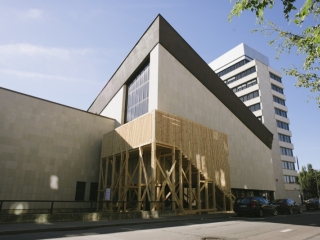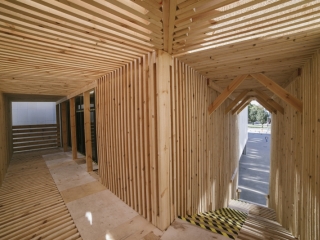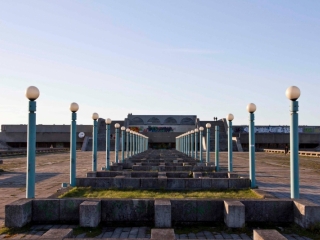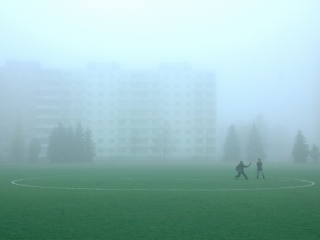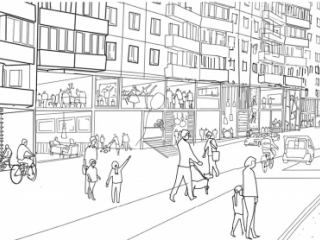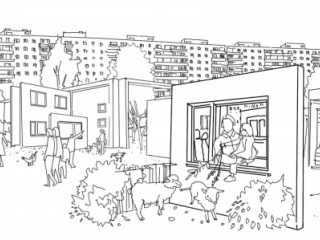- INTRODUCTION
- LECTURES
- A_Mart Kalm / Modernism In Estonia: From Industrialist’s Villa To Kolkhoz Centre
- B_David Crowley / The Fate of the Last Generation of Ultra-Modernist Buildings in Eastern Europe Under Communist Rule
- C_ Claes Caldenby / Urban Modernity. Nordic-Baltic Experiences
- D_Marija Drėmaitė And Vaidas Petrulis / Modernism In Soviet Lithuania: The Rise And Fall Of Utopia
- E_Anna Bronovitskaya / Glimpses Of Today In Visions Of Russian Avant-Garde Architects
- ESSAYS
- Ernestas Parulskis / Commemorative Plaques In Lazdynai
- Indrė Ruseckaitė and Lada Markejevaitė / Elena Nijolė Bučiūtė’s Personal Modernism
- Maija Rudovska / In The Shadows Of Nostalgia. Marta Staņa’s Legacy In Latvia
- Liina Jänes / Position Of The “Other”: The Architecture Of Valve Pormeister
- Julija Reklaitė / Amber Inclusions. What Modernist Memorabilia Can Tell Us
- INTERVIEWS
- Talking About the Richer Picture. An Interview with David Crowley by Aistė Galaunytė
- An Active Archive For A Public Discussion. An Interview with Hartmut Frank by Eglė Juocevičiūtė
- Cheating The Space Or Cheating The Time. An Interview with Frédéric Chaubin by Eglė Juocevičiūtė
- More Freedom, More Privacy. An Interview with Anna Bronovitskaya by Eglė Juocevičiūtė
- Sinchronicity of Ideas. An Interview with Andres Kurg by Eglė Juocevičiūtė
- Recycling Socialism. An Interview with Aet Ader by Viktorija Šiaulytė
- ABOUT
ALF 02
Recycling Socialism. It is architect’s job to inspire and explain what other solutions could be made. Interview with Aet Ader by Viktorija Šiaulytė
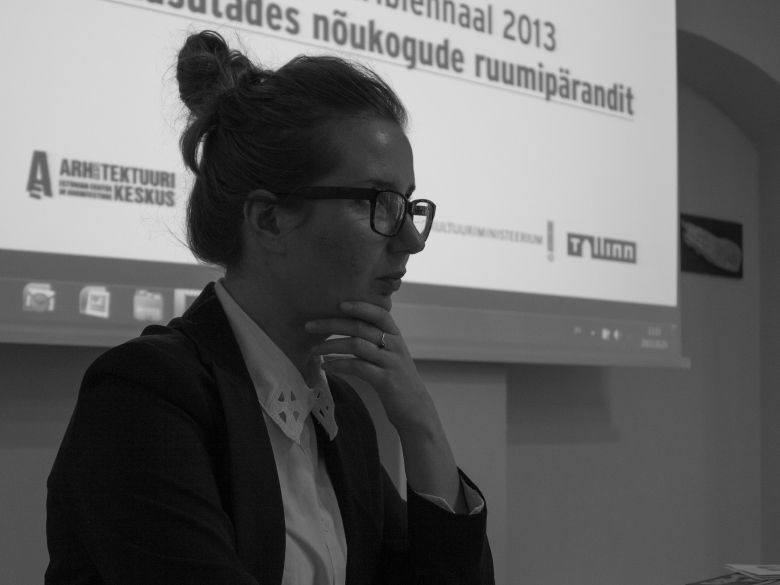
Aet Ader during the seminar in Vilnius, October 25th, 2013. Photo: Ieva Marija Malinauskaitė
Aet Ader (1985) is an architect and co-editor of Ehituskunst, the bookazine of architecture and spatial thought. She graduated from the Estonian Academy of Arts, Faculty of Architecture and also studied in Copenhagen. Aet is one of the founders of studio b210 (www.b210.ee), an office for architecture and art in Tallinn, Estonia. She and her colleagues designed the Anne Youth Centre in Tartu and the ship model testing and laboratories building for Tallinn Technical University Kuressaare College. She is one of the authors of the Tallinn Planning Guide and in summers she participates in urban installations, such as the project O along with her friends. Aet was one of the curators of the Tallinn Architecture Biennale 2013: Recycling Socialism.
Why did you take “Recycling Socialism” as a topic for the Talinn Architecture Biennale of this year?
This was our personal choice. Last time (2011) the topic of TAB was Landscape Urbanism, and in my opinion “landscape urbanism” as a topic in the Estonian or Nordic-Baltic regional context does not raise many critical questions. It is a theory of urban planning arguing that the best way to organize cities is through the design of the city's landscape, rather than the design of its buildings. One of the best examples of this method in practice is a studio in the AA School in London, led by Eva Castro. It is a great method to practice architecture in an international context, but Tallinn, Estonia with its low density and emptiness might not be as good an example as the megapolises around the world. Our aim with the topic “Recycling Socialism” was to raise a question vital in Estonia, but also in the wider context of Eastern Europe, and around the world. We always had in mind the Soviet space, our only concern was that this topic has been discussed a lot already. The topic of the Estonian exposition in the Venice Architecture biennale was called “How long is the life of the building?”, the essays in the catalogue raised some really important questions. We sensed that this was a good starting point, but there were no proposals, no answers. With TAB we wanted to take the discussion further by gathering architects-visionaries from all around Europe to find ideas for the future.
In the framework of the biennale, the given era is limited from the 1960s through the 1980s, when unprecedented forms and urban dimensions appeared in the cityscape. In the course of a massive production of space, glorious ideologies were poured into concrete moulds for a society that never came to be. Contemporary society lives in a world of individuality and customizability, but the awkward moulds are still here – in Tallinn, in Estonia, in Eastern and Central Europe, in Europe at large and all over the world. We have reached a turning point when many European architects consider this as historical architecture, from an era preceding their own personal experience, to be uncovered and explored. These spaces constitute an abundant collection from which to rediscover projects, materials, ideas and stories. Which are the most valuable finds and what is there to recycle for the future?
We invited some architects, who hadn’t had any working experience on the Soviet space before, but of course also architects like Łukasz Wojciechowski from Poland, who mainly deal with the same issues. The works presented in the Curators’ Exhibition are not only practical answers, they are interpretations. That was also one of our ideas – to have a diversity of views on the topic, not necessarily agreeing with each other. For example, inviting Dorte Mandrup, who presented Nordic hands-on approach, respectful and very practical suggestions on how to improve the life of the Lasnamäe dwellers and how to make their surroundings and apartments more up-to-date.
Pier Vittorio Aurelli from Dogma quite bravely followed the original Socialist ideas and revived them for the present creative class. He proposed a new type of a dwelling next to the Balti railway station. The dwelling would inhabit 1600 creative workers who would have multipurpose living and working units in the building.
Maybe one of the most radical proposals was from Benjamin Dillenburger from ETH Zürich, who has been researching new 3D printing methods. We assigned him a 1-464 type apartment building, to which he proposed to smash all these panels into gravel or sand and reuse it for printing a new building.
If you read the catalogue, you will find the work and text by Vladimir Frolov and Alexei Levchuk from St. Petersburg. They dealt with the cinema Kosmos and their idea was to keep it as an untouched monument for the Soviet times, because the cinema played a very special role in Socialist countries, it was run by the state and had an ideological programme. It was a time and space travel machine for the people in the Soviet times, to foreign countries through foreign films, where travelling in real life was usually banned. Their concept of the “Theatre of Nothing” would keep the cinema as it is, the screen empty with no message. This is one way of interpreting that function – making it into a really poetic one.
What kind of brief did you provide for the people you invited? Did you “pair” them up to work with particular buildings?
In January we had a workshop with the students of the Estonian Academy of Arts, Department of Architecture where we researched 12 buildings in Tallinn, gathering texts, images, plans and all the information we had discovered. Students also wrote essays about their personal perspectives towards these buildings. Then we put together the brief for the invited architects, where we asked “What is there to recycle (and how) from the architecture, structures, projects, ideas, concepts, and materials of Socialist space?” Each team received an accompanying folder with information about the building that awaited their interpretation. We also had a student as a local contact for all the 12 teams, so the architects could ask some more specific questions. We explained the topic but we also gave a free hand for the format and how to express ideas – it was left open for the teams, either they chose to do a model, a visualization, an installation or something else.
What did you learn yourself from the proposals and feedback that you got from the participants? Could you tell us something about the proposals that were most surprising to you?
I think everything was really surprising. Maybe we expected more practical approaches, which was usual for architects, but many of the works were quite artistic. For example, the Salto’s Flower Pavilion project which dealt with the interior space and how the ground floor should not be fixed. The original concept of the Flower Pavilion in 1960 was that the floor did not have a finish; it was pure earth which could be reshaped and redesigned every time, so that the space was ever-changing. The Salto architects proposed to rebuild the varying floor in a new way, vertically movable platforms that give different spatial configurations, which allow the patrons to organize concerts and other public events in the building. This is an interesting way of amplifying the original concept of the building.
Also 3+1 Estonian architects worked on the State institute design building, Viru hotel and Linnahall are situated on the same axis. During Soviet times there was a general plan to have a great axis from the city centre towards the sea in Tallinn. You cannot feel this axis anymore because they did not finish it, only if you are on top of the Linnahall could you notice the remains of the visual connections and some parts of the road along the axis. The 3+1 architects did not provide a solution as to what should be done exactly, they did a digital, abstract interpretation, emphasizing this axis – perhaps saying that we should still have great ideas of urban planning. Tallinn is really eclectic and there are not many ideas on the whole city scale. So it is a little bit of a critique on our town planning.
As a conclusion, the question for myself is how to continue with all that. We collected these 12 ideas and they are great. But where can we go further? How could we lobby these ideas? Even though they are not really concrete, did it influence anybody? Are there any further discussions about it? For example, we thought we should take the model by Dorte Mandrup to the Lasnamäe locals and explain it to the local city government – to take it more out of the biennale context.
Did the proposals instigate any specific discussions?
The biennale was covered in all the newspapers and some of the articles were really interesting. Off the top of my head I cannot name a specific question that it raised, but it really worked on a simple level in that people started to see these buildings. I think it is important that people value it as architecture. Most of the Soviet architecture is not under protection, only a few cases are listed. My point is not to say that everything has to be restored, but just to have a discussion on what to keep and what not. Many people started to become interested in the building of the Ministry of Foreign Affairs. A UNESCO meeting will be taking place in Tallinn and they wanted to have it in the hall where the Curators Exhibition took place, the hall which we opened for the first time to the public. Also some band or book presentations have shown their interest in that room. Though we took down the installation stairs by Tomomi Hayashi, because it only had permission for six weeks and now there is no direct access to the hall. People in the Ministry of Foreign Affairs seemed to be really positive about starting to use the hall – as all the architects who came there to the event expressed the value of their building.
Also there has been a lot of negativity towards Linnahall, “it is full of graffiti and it is leaking”. When we had the exhibition in the lobby, some people thought maybe it could be discussed with the owner – the city authorities – to see if there could be a permanent exhibition space in Linnahall. It is so nice – the lobby is a high and narrow space, not a typical white box. If the city agreed with all these small things, it would be really great.
I wonder, what kind of platform is TAB? You proposed some solutions for certain buildings, but you are not the commissioner or developer and what will happen with these proposals of the biennale?
Tallinn city government is our partner. They supported the Vision competition in Õismae, and many other things. I think it is possible to negotiate it, but in a way, you are right. It is just a biennale, it is just an event. We have no right to say: “Haven’t you seen it? It works! Shouldn’t it be like that?” We can just talk about it.
But somehow it is still important to have these concrete proposals exhibited.
In a way people see that there is a potential (positive perspective for the Soviet architecture), these kind of events show them that changes are possible and that there is initiative for realizing these ideas. Even placing the stairs next to the Ministry of Foreign Affairs building was quite doubtful for us in the beginning, it is not that easy to build temporary constructions. It takes time and a lot of explanation work to get all the papers done – security matters, fire protection regulations, all that kind of thing. Thus, this installation is a good example for the future – that if people want to do installations of that kind, they will remember that it is possible.
What was your motivation for the Vision Competition?
The Vision competition was the first public appearance of TAB in the spring of 2013. As we chose Recycling Socialism as a main theme, we planned that the Curators’ Exhibition would focus on single objects and the Vision competition would cover some area of Tallinn. We asked for proposals for the Vaike-Õismae district.
Väike-Õismäe is one of Tallinn's three larger Soviet-era panel-apartment districts, which differs from the other similar areas by way of its concentric plan derived from the idea of a circle-city. The district is positioned circularly as a single complete solution around a pond in the middle. On the one hand, Väike-Õismäe, which was recognized with a national award upon its completion in the 1980s, is a clear underlying structure for further developments. On the other hand, this circle-based plan is also a limitation that gives the illusion of a functional whole, but where – similarly to other modernist apartment block areas – a common language between the environment and modern-day life is still to be searched for.
The jury comprised of Estonian architect Inga Raukas, Bjarke Ingels from the BIG office from Denmark, and Endrik Mänd, the head city architect in Tallinn. The winning entry was called “DYNAMO” – an international group of architects, who studied together in the STRELKA Institute for media, architecture and design in Moscow last year. Somebody mentioned yesterday Kuba Snopek’s Belyavo project [http://issuu.com/strelkainstitute/docs/belyaevo_forever]. They could have been related to the same studio project and they already had a background for dealing with a microrayon district. They proposed a solution where they reused wall panels from the ground floor – took them away and with this gesture joined the ground floor space under the building to the public space next to the buildings. These panels were reused to create pavilions in the central area, the open space there in the middle of Väike-Õismäe.
For me personally, if I look at all the vision competition entries, I was surprised that not many people dealt with the buildings themselves. I think some key questions are related to the buildings, for example ‘khrushchevkas’, the smallest apartments where the ceilings are 2.5m and the kitchen is around 3.7 sq. m. For me it is still a question of whether these apartments really fit our living standards nowadays. How can we change the structure, or how can we change the layout? Then possibly how can we change the façades? As we saw from David’s presentation and the Park Hill example, where they changed the façade slightly, introducing some colour and making the windows bigger, and it’s already had a different image in the minds of the people. I would say the questions are how we can change the layout and how we can change the façades, and then what happens to the public space, from inside to outside; it is all related.
There is often not only a problem of finding ways to recycle the Socialist architectural structures, but also of the current legal and ownership structures that make it difficult for a total make-over to happen.
Yes. But it actually could be possible within a single building. Engineering students with their tutors from Tallinn University of Technology researched the constructions of 121 series prefabricated housing, which were built in the 1970s and the later version in the 1980s. They found that it is possible to take the construction panels off and change them instead with steel pillars in order to create an open space. Of course, there is always a question of how much it would cost. I think some flexibility is possible in terms of construction, even when different people are owners of each single apartment.
How is Socialist architecture being ‘recycled’ on the governmental level in Estonia?
Maybe in Tallinn not so much. But for example, we (b210 architects: Aet Ader, Kadri Klementi, Karin Tõugu, Mikk Meelak, Kaidi Õis, Grete Soosalu, Kalle Komissarov) won a project in Rakvere, a small town in central Estonia. It was an architecture competition financed by the EU project “Urban Energy”. They asked for a renovation project for 18 apartment buildings and a street in-between, which was too wide and not in use. We proposed a project making the street into a linear park with public functions there and a new design for 8 types of apartment buildings. We did the first phase of design to all 18 buildings in the area, with this being financed by the city. So, all the residents got a free primary design for a renovation project for their building. I think the city made it obligatory to follow the proposed design in the area; the aim was to gradually develop the whole area following the same principles. I think up until now two of the buildings have commissioned final construction projects. But some of them are still thinking. It is an issue of money, they still have to finance the construction. There are some support funds, such as KredEx – a specific state institution where you can apply and acquire some support and a really cheap loan from the Apartment Union. It seems to work, but people choose the simplest things, they choose to insulate their buildings, they do not see a good reason to undertake large scale changes, something that would change the way they live. One can understand that, because there are a lot of old people living in these areas and they do not have much money to invest. They choose the easiest thing to do, which will change more or less just the level of energy consumption. Energy saving is important, but this is only half of the problem.
If you compare what TAB proposed and what discussions came about and what kind of discussions are taking place on the political level – are there any meeting points?
Of course there is a great difference. Apartment buildings are in a way the most difficult challenge. One important aspect is to educate the people, show these proposals made by architects and explain the possibilities. If they do not see any options in a larger scale, they just see the other buildings around which were insulated and painted yellow, maybe they decide – “we’ll insulate it and we’ll paint it green”. Unfortunately, sometimes this is all the limited discussion there is. It is the architect’s job to inspire and explain what other solutions could be made.
The KredEx institution is a good move by the government, they see the problem. But mainly they see the problem that the heating costs in Soviet era buildings are too high. We have to take this discussion a little bit further – how we want to live, how we want to live in the future...talk about architecture.
Do you think there are also some topics, proposals, or ideas that emerged in the biennale which would be actual outside of the post-Socialist space?
Totally. Many ideas. There are similar problems in post-Soviet countries, also in former Yugoslavia or even in France, as modernism was really common there. The way they build in China – they are still doing it, they are following the same scheme. I think many similar problems will appear there. From a positive perspective – most of the Soviet buildings are still in use, modernist housing areas are full of people in Tallinn. As long as people still like to live there and they care about it, then there is potential for positive developments.
Straipsnis PDF formatu:
http://leidiniu.archfondas.lt/sites/default/files/175-184_interview_aet%20ader.pdf







